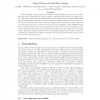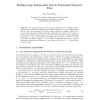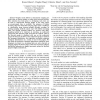335 search results - page 5 / 67 » Resolvent of large random graphs |
RSA
2008
13 years 7 months ago
2008
: We study a model of random uniform hypergraphs, where a random instance is obtained by adding random edges to a large hypergraph of a given density. The research on this model fo...
ISCIS
2005
Springer
14 years 1 months ago
2005
Springer
Dense subgraphs of sparse graphs (communities), which appear in most real-world complex networks, play an important role in many contexts. Computing them however is generally expe...
WAW
2004
Springer
14 years 29 days ago
2004
Springer
We study a random graph Gn that combines certain aspects of geometric random graphs and preferential attachment graphs. The vertices of Gn are n sequentially generated points x1, ...
CPC
2006
13 years 7 months ago
2006
We consider instances of the maximum independent set problem that are constructed according to the following semirandom model. Let Gn,p be a random graph, and let S be a set consis...
INFOCOM
2012
IEEE
11 years 10 months ago
2012
IEEE
Abstract—Despite recent efforts to characterize complex networks such as citation graphs or online social networks (OSNs), little attention has been given to developing tools tha...



